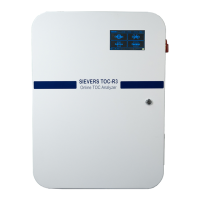INSTALLATION
Chapter 3
............
Sievers TOC-R3 Operation and Maintenance Manual
DLM 95000-01 EN Rev. A 57 © Veolia 2023
• Located away from excessive EMI (electromagnetic interference)
• Located away from, or isolated from, excessive vibration
• Vented drain point must be located lower than the Analyzer level (to minimize
back-pressure of the gravity drain lines)
Sample Considerations
• Sample Temperature: Up to 60 °C (140 °F) as standard
• Sample particles: 1-1.2 mm soft particles, 0.2-0.5 mm hard particles.
• Smallest Analyzer tubing is 2 mm ID.
• Flow rate 100 mL/minute minimum.
• Sample Pressure less than 20 kPa (0.2 bar, 2.9 psig) at the Analyzer.
• Sample Pressure should not exceed 20 kPa, (0.2 bar, 2.9 psig)!
• Maximum sample tubing length from water sampling point less than 2 m (6.5 ft)
• Sample point(s) within 2 m (6.5 ft) of tubing run from Analyzer
• For each Sample point (up to two), there must be an individual Shut-off Valve
installed.
• Vented gravity drain tubing must be positioned lower than the level of the Analyzer
to minimize back pressure (less than 0.07 Bar, 1 psig) on the drain line.
Power Requirements
• (110-230) VAC ±10 V
• 50/60 Hz
• 400-600 VA
• Protective earth ground incorporated into the AC Mains supply power cord
Carrier Gas
The Analyzer requires CO
2
-Free: < 1ppm CO
2
. Hydrocarbon Free: < 0.1 ppm, moisture
and particle free as per ANSI 7.0.01 for instrument air.
This can be achieved in the form of Nitrogen, Zero/Synthetic Air, Plant Instrument Air, or
the optional Air Box Accessory. If using Plant Instrument Air, the Analyzer will require the
Air Scrubber Accessory. If using an external air connection, there must be an appropriate
Pressure Regulator (Maximum of 100 kPa,1 bar, 14.5 psig) and Shut-off Valve installed
near the Analyzer location.
• Options: Nitrogen, Zero/Synthetic Air, Plant Instrument Air (ANSI 7.0.01), or Air
Box Accessory.
• Pressure: 100-200 kPa (1-2 Bar, 14.5-29 psig)

